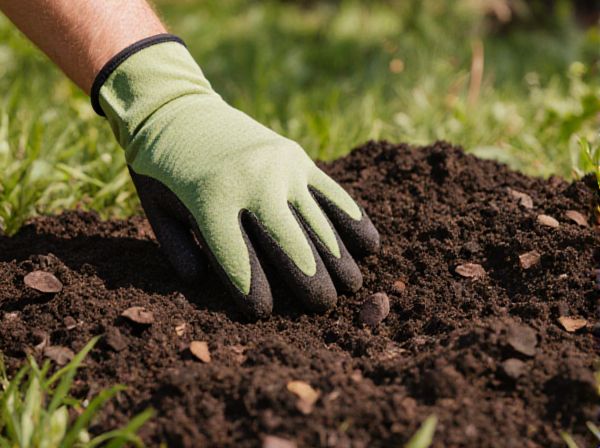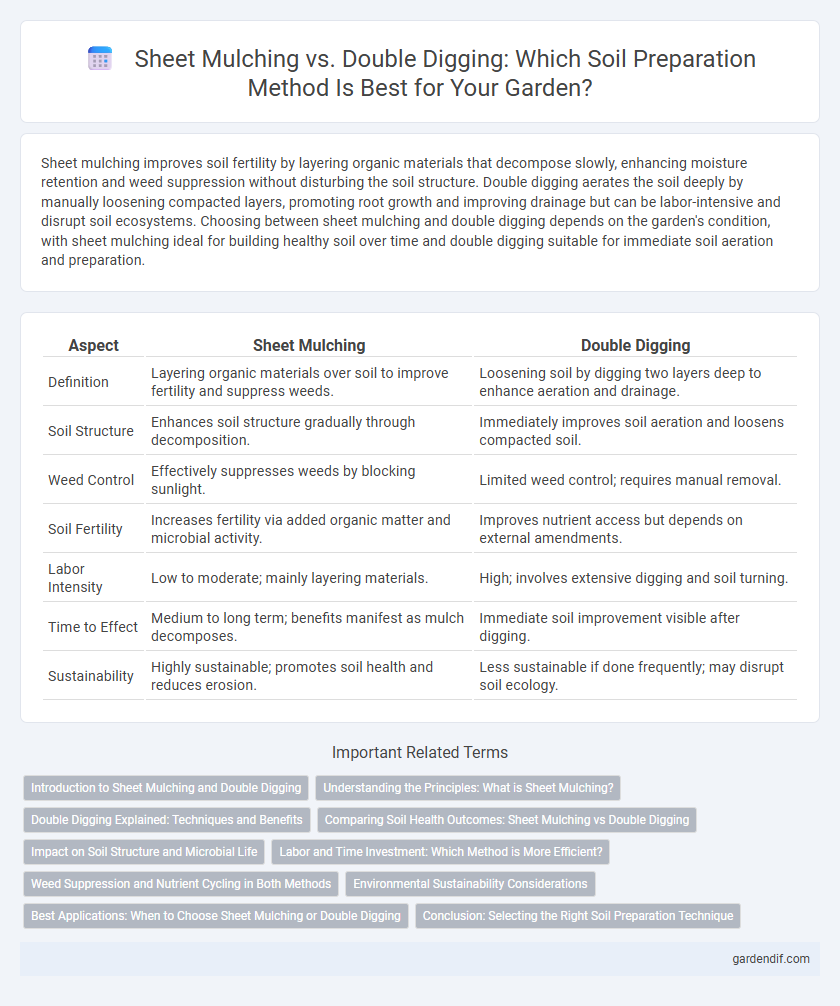
Sheet Mulching vs Double Digging Illustration
Sheet mulching improves soil fertility by layering organic materials that decompose slowly, enhancing moisture retention and weed suppression without disturbing the soil structure. Double digging aerates the soil deeply by manually loosening compacted layers, promoting root growth and improving drainage but can be labor-intensive and disrupt soil ecosystems. Choosing between sheet mulching and double digging depends on the garden's condition, with sheet mulching ideal for building healthy soil over time and double digging suitable for immediate soil aeration and preparation.
Table of Comparison
| Aspect | Sheet Mulching | Double Digging |
|---|---|---|
| Definition | Layering organic materials over soil to improve fertility and suppress weeds. | Loosening soil by digging two layers deep to enhance aeration and drainage. |
| Soil Structure | Enhances soil structure gradually through decomposition. | Immediately improves soil aeration and loosens compacted soil. |
| Weed Control | Effectively suppresses weeds by blocking sunlight. | Limited weed control; requires manual removal. |
| Soil Fertility | Increases fertility via added organic matter and microbial activity. | Improves nutrient access but depends on external amendments. |
| Labor Intensity | Low to moderate; mainly layering materials. | High; involves extensive digging and soil turning. |
| Time to Effect | Medium to long term; benefits manifest as mulch decomposes. | Immediate soil improvement visible after digging. |
| Sustainability | Highly sustainable; promotes soil health and reduces erosion. | Less sustainable if done frequently; may disrupt soil ecology. |
Introduction to Sheet Mulching and Double Digging
Sheet mulching is an organic gardening technique that improves soil fertility by layering compost, cardboard, and mulch to suppress weeds and enhance moisture retention. Double digging involves manually loosening the soil to a depth of two shovels, promoting aeration and root growth for intensive garden beds. Both methods aim to boost soil health but differ in labor intensity and immediate soil structure impact.
Understanding the Principles: What is Sheet Mulching?
Sheet mulching is a soil improvement technique that involves layering organic materials such as cardboard, compost, and mulch over the soil surface to suppress weeds, retain moisture, and enhance soil fertility. This method mimics natural forest floor processes by promoting beneficial microbial activity and slow nutrient release, leading to healthier soil structure. Unlike double digging, sheet mulching minimizes soil disturbance while gradually enriching the soil ecosystem.
Double Digging Explained: Techniques and Benefits
Double digging is a deep soil cultivation technique involving the removal and loosening of two layers of soil to enhance aeration and root penetration. This method improves soil structure, increases nutrient availability, and promotes better water retention compared to surface-level amendments like sheet mulching. Gardeners often adopt double digging to optimize soil health and boost plant growth in compacted or poor-quality soils.
Comparing Soil Health Outcomes: Sheet Mulching vs Double Digging
Sheet mulching enhances soil health by improving moisture retention, promoting microbial activity, and suppressing weeds with a natural organic barrier. Double digging aerates the soil deeply, increasing oxygen flow and root penetration, but may disrupt soil structure and organic matter balance if done frequently. Comparing outcomes, sheet mulching fosters sustainable soil ecosystems over time, whereas double digging provides immediate soil loosening but risks long-term soil degradation without careful management.
Impact on Soil Structure and Microbial Life
Sheet mulching improves soil structure by enhancing moisture retention and organic matter content, fostering robust microbial communities through gradual decomposition of layers. Double digging aerates the soil deeply, disrupting compacted layers and promoting root penetration, but may temporarily disturb microbial habitats and soil stratification. Both methods influence soil biology differently: sheet mulching supports gradual microbial biomass increase, while double digging accelerates nutrient cycling by exposing deeper soil layers to oxygen and microbial activity.
Labor and Time Investment: Which Method is More Efficient?
Sheet mulching requires less labor and time investment compared to double digging, making it more efficient for gardeners seeking quick soil improvement. Double digging demands significant manual effort and can take several hours per square meter, while sheet mulching involves layering organic materials that naturally break down over weeks. This method not only conserves energy but also enhances soil structure and fertility with minimal disturbance.
Weed Suppression and Nutrient Cycling in Both Methods
Sheet mulching effectively suppresses weeds by blocking sunlight and creating a thick barrier of organic material that decomposes to enrich soil nutrient cycling. Double digging aerates the soil deeply, enhancing microbial activity and nutrient availability while physically uprooting weeds to reduce competition. Both methods improve soil health, but sheet mulching offers continuous weed suppression and gradual nutrient release, whereas double digging accelerates nutrient cycling through soil disturbance.
Environmental Sustainability Considerations
Sheet mulching enhances soil health by reducing erosion, conserving moisture, and promoting beneficial microbial activity through organic matter integration, making it a low-impact, sustainable practice. Double digging improves soil aeration and nutrient availability but disturbs soil structure and microbial habitats, potentially leading to increased carbon release and erosion risk. Prioritizing sheet mulching supports long-term environmental sustainability by maintaining soil integrity and reducing the need for chemical inputs.
Best Applications: When to Choose Sheet Mulching or Double Digging
Sheet mulching is best suited for improving soil health in garden beds with heavy weed presence or poor organic matter, offering a no-dig, low-labor method to enrich soil structure and moisture retention. Double digging is ideal for new garden plots with compacted or clay soils, as it aerates deeply and enhances root penetration, making it effective for intensive vegetable gardening or perennial planting. Choosing between these methods depends on soil condition, labor availability, and desired speed of soil improvement.
Conclusion: Selecting the Right Soil Preparation Technique
Sheet mulching enhances soil fertility and moisture retention by layering organic materials, making it ideal for sustainable gardening and weed suppression. Double digging improves aeration and root penetration through deep soil turnover, best suited for intensive vegetable cultivation requiring immediate productivity. Choosing between these techniques depends on soil health goals, garden scale, and long-term maintenance capacity.
Sheet Mulching vs Double Digging Infographic

 gardendif.com
gardendif.com